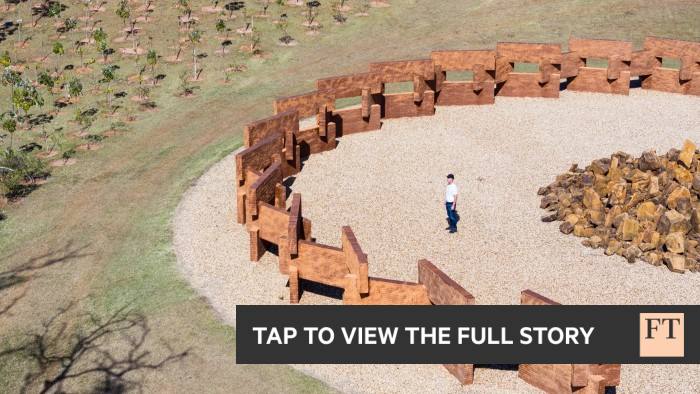Throughout their professional lives, the Campana brothers were primarily recognized for their whimsical furniture crafted from numerous stuffed toys stitched together in a moment reminiscent of Frankenstein’s creation. These pieces became commodities in the booming collectibles market, a profitable convergence of fine art and design where functionality took a back seat. An example of their artistry, the Campana brothers’ Panda Banquete chair dating back to around 2005 fetched $44,100 at a Christie’s auction last year.
However, the intrinsic value of joy is immeasurable, and these creations were brimming with it. While they stood out as remarkable and groundbreaking designs, they also exuded a sense of novelty and humor, leading to widespread imitation. Even after Fernando Campana’s passing in 2022 at the age of 61, potentially not even at the peak of his career, Humberto has continued the legacy. The current exhibition, On the Road, showcased at Gallery in New York, marks his debut as the lead designer while staying true to the fundamental principles of their studio on its 40th anniversary.
Before Fernando’s demise, the brothers collaborated on the ambitious Parque Campana, set to open in June under Humberto’s direction. This park, sprawling across 52 hectares of farmland just a two-and-a-half-hour drive from São Paulo near their hometown of Brotas, delineates the future legacy of the Campana brothers.
“We inherited the land from our father with the initial idea of preserving it as a natural sanctuary,” explains Humberto. “Fifteen years ago, we planted 15,000 indigenous trees without any concrete development plans. Being perpetual nomads, we leased it to cattle farmers primarily as a protective measure.”
However, amidst the pandemic, Humberto and Fernando deliberated on their global ventures and public engagements, leading to the conception of a visionary project for their hometown. This vision entailed an architectural marvel where nature dictated the design using bamboo, cactus, and agave. Inspired by their Italian heritage and the 12 cities of Tuscany, the brothers envisioned 12 pavilions to establish a connection with their roots and international acclaim.
A poignant short film released in 2022, shortly before Fernando’s passing, captures the brothers traversing the nearly completed sculpture park. In the film, Fernando articulates the essence of Parque Campana: “It’s a space where the genetic code of our furniture can be seamlessly integrated into nature on a grand scale.” Notable features include the Bamboo Cathedral with sandstone loungers arranged in a circular fashion, the Eucalyptus Pavilion reminiscent of Oscar Niemeyer’s Brasilia architecture, and the Concrete & Agave Pavilion showcasing a field of concrete columns adorned with agave plants of varying heights, strategically angled to avoid a funereal appearance.
The park’s full realization will unfold over several years, encompassing a restaurant featuring locally sourced ingredients, a museum, and a workshop dedicated to preserving significant Brazilian crafts. Humberto acknowledges the current lack of shade in many areas and emphasizes ongoing efforts to plant more trees to address this issue. Collaborating with Gerd Spavorek, a retired soil sciences professor from the University of São Paulo, Humberto aims to restore the landscape to its original state, aligning with the region’s indigenous flora and fauna.
From Naoshima to Yorkshire, sculpture parks have emerged as a global phenomenon, resonating with an era where environmental concerns have escalated to both a source of distress and a societal imperative. While art appreciation has always been a prevalent desire, there is now a pronounced inclination towards experiencing nature firsthand. Humberto’s recent works increasingly reflect his environmental consciousness. The Hybridism collection, one of the final collaborations with his brother showcased in London in 2019, featured cast-bronze animal sculptures, chairs, and cabinets adorned with repurposed Amazonian fish skin, drawing inspiration from the narrative of Noah’s Ark and utilizing materials indigenous to South America.
“In November, Brazil experienced a severe heatwave resulting in the scorching of all vegetation. Witnessing the devastating impact on flora and fauna fills me with dread. The rampant environmental degradation, including reports of drug cartels encroaching on natural reserves, particularly in the Amazon and Galápagos, underscores the pervasive corruption in Latin America. Our environment is imperiled by criminal exploitation,” laments Humberto. Despite his prevailing anxiety, the Parque Campana project instills a sense of hope and purpose, serving as an educational platform on environmental issues alongside its artistic significance, intended as a sanctuary for reflection and rejuvenation.
Revisiting his childhood haven of Brotas evokes a wave of nostalgia for Humberto. It was here that their artistic inclinations were nurtured by supportive mentors, and the vibrant hues of stained glass in their local church kindled their appreciation for color in design during weekly masses. Reflecting on the park’s creation, Humberto muses, “This endeavor is akin to an amusement park for me, evoking cherished childhood memories. I vividly recall the cacti wall dividing our property from the neighbors and the bamboo treehouse we fashioned. Escaping into the realm of cinema with my brother and reimagining those narratives in our backyard was our form of escapism.”
The monumental scale and artistic composition of the park’s pavilions evoke a sense of wonder and enchantment. The meticulously arranged structures across this vast landscape exude a magnetic allure, destined to draw visitors from afar. The ambiance exudes an aura of ceremony, enchantment, and whimsy, magnifying the Campana Brothers’ creative essence on a grand scale. While Humberto regrets his brother’s absence to witness this spectacle, he finds solace in symbolic gestures like planting a weeping fig tree in his honor at the heart of the park.
